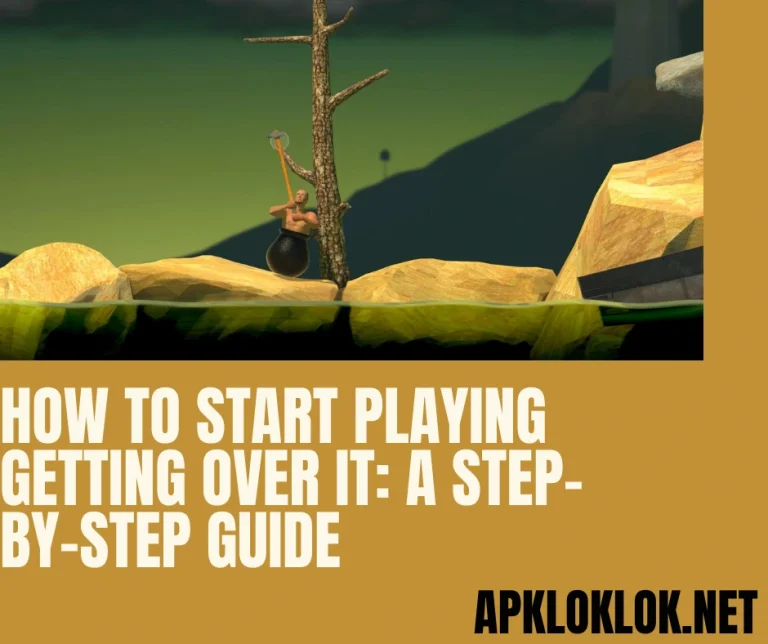The Psychology of Getting Over It APK: Why We Can’t Stop Playing
Getting Over It Apk is a test of mental endurance. The game presents players with one clear goal climb a mountain using only a hammer and a pot. But the journey to the top is very simple but frustrating. Its combination of frustrating gameplay and philosophical undertones makes it more than just a game.
Getting over it gameplay tests your patience, determination, and even your ego. Why, then, do so many players keep coming back for more despite the frustration? It’s because the game taps into the human desire for mastery and resilience. Each fall is a test of willpower, and each tiny success feeds a need to prove that the challenge can be overcome.
The game creates a loop of frustration and hope. Every fall from a high point hurts, but it also makes players more determined to get back up and try again. The mind sees every setback as temporary, and the lure of mastering the seemingly impossible controls keeps players hooked. The sense of reward after each tiny victory is magnified because of the struggle it took to get there.
Watch This Tutorial and Understand Why We Can’t Stop Playing
Challenge and Mastery
Getting Over It APK latest version taps into our desire for mastery. The controls are intentionally awkward, and progress is slow. Each success, no matter how small, feels hard earned. This incremental progress hooks players by offering a continuous challenge. The more difficult something is to achieve, the more rewarding it becomes. This is why players return, even after repeated setbacks.
Key Insight
The steep learning curve forces players to improve their skills. Over time, players find themselves getting better at handling the hammer, which gives a sense of accomplishment.
Frustration Loop
Falling in Getting Over It isn’t just a minor setback it often sends players all the way back to the beginning. This induces frustration and even anger. However, this negative experience is what drives the addiction. Psychologically, our brains are wired to seek resolution when faced with a challenge. Each fall creates a sense of unfinished task, making players feel compelled to try again.
Key Insight
The emotional rollercoaster of frustration and hope is what keeps players engaged. The potential for a big comeback after a fall makes every attempt feel like a chance to redeem yourself.
Philosophical Reflection
Bennett Foddy provides philosophical commentary throughout the game. As players struggle to climb, Foddy delivers thoughts on failure, perseverance, and human nature. These reflections often mirror the player’s own experience. This unique narrative style adds a deeper layer to the game, making it more than just about gameplay it’s about self-reflection.
Key Insight:
The game uses failure as a theme not just in mechanics but in its narrative. Players are encouraged to reflect on how they handle frustration, which adds a mental challenge to the physical one.
The Real Truth of Getting Over It with Bennett Foddy
The real truth about “Getting Over It” is that it’s a game designed to make you fail—and that’s the point. Bennett Foddy created the game with the intent of challenging players in a way that most games don’t. Most games give you checkpoints, easy modes, and ways to soften the blow of failure. Getting Over It does the opposite. Each fall can undo hours of progress, and the Foddy himself narrates the game with philosophical quotes about failure, reminding you that setbacks are part of the journey.
The game teaches you how to cope with failure, not just in the game but also in real life. It’s a metaphor for persistence and resilience. You learn that falling isn’t the end but just a part of the process. In a way, it teaches players a harsh but valuable lesson: keep going, no matter how many times you fall.
What I Learned from Beating Getting Over It 50 Times
Beating Getting Over It once is an achievement in itself, but doing it multiple times teaches you something deeper about both the game and yourself. After conquering the game 50 times, you start to see patterns not just in the game’s layout but in your own reactions to it. The first few playthroughs might fill you with rage every time you fall, but over time, you learn to accept failure as part of the process.
What stands out most is how the game forces you to stay calm under pressure. Every small movement matters and frustration only makes you lose control. Beating the game multiple times teaches you patience, precision, and the ability to stay composed even when everything feels like it’s falling apart. It becomes less about reaching the top and more about controlling your emotions during the journey.
Is Getting Over It a Hard Game?
In short, yes Getting Over It is a challenging game, but its difficulty isn’t about complicated mechanics or intense action. Instead, it’s difficult because it plays with your expectations. The controls are intentionally awkward, and the game’s physics make it easy to slip up and lose progress. One small mistake can send you tumbling down the mountain, erasing hours of work in seconds.
But the game’s difficulty is also what makes it rewarding. Every inch of progress feels like a battle won. The difficulty isn’t just about skill but also about mental toughness. You need to stay calm, focused, and patient, which makes Getting Over It more about controlling your emotions than mastering the mechanics.
What is Stage 2 of Getting Over It?
Stage 2 is usually considered the point after you’ve passed the early parts of the game, such as the initial tree and house climb. At this stage, you’ll encounter trickier obstacles like the construction site and the infamous Orange Hell.
This part of the game is particularly notorious for its ability to make players fall back to the beginning if they make one wrong move. It’s a significant step up in difficulty, requiring more precise movements and a better understanding of the game’s controls. Passing Stage 2 is often where players start to feel like they’re making real progress, but it’s also where the real challenge begins.
Conclusion
The psychological grip of Getting Over It lies in its ability to challenge, frustrate, and reward players all at once. It’s a game that taps into our innate desire to overcome obstacles and prove ourselves, even when the odds are stacked against us. The blend of frustrating gameplay, philosophical commentary, and community-driven competition creates an addictive experience that keeps players coming back for more.
So, why can’t we stop playing? The game doesn’t just test our gaming skills it tests our resilience, patience, and ability to cope with failure. And that’s a challenge many of us can’t resist.





